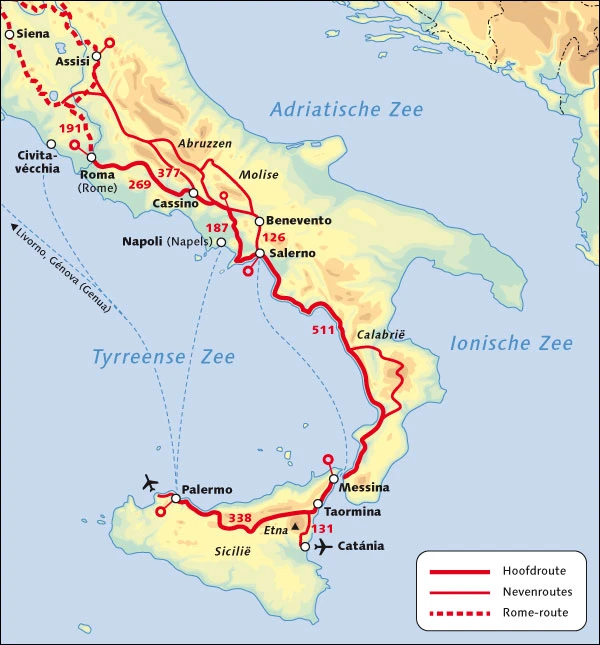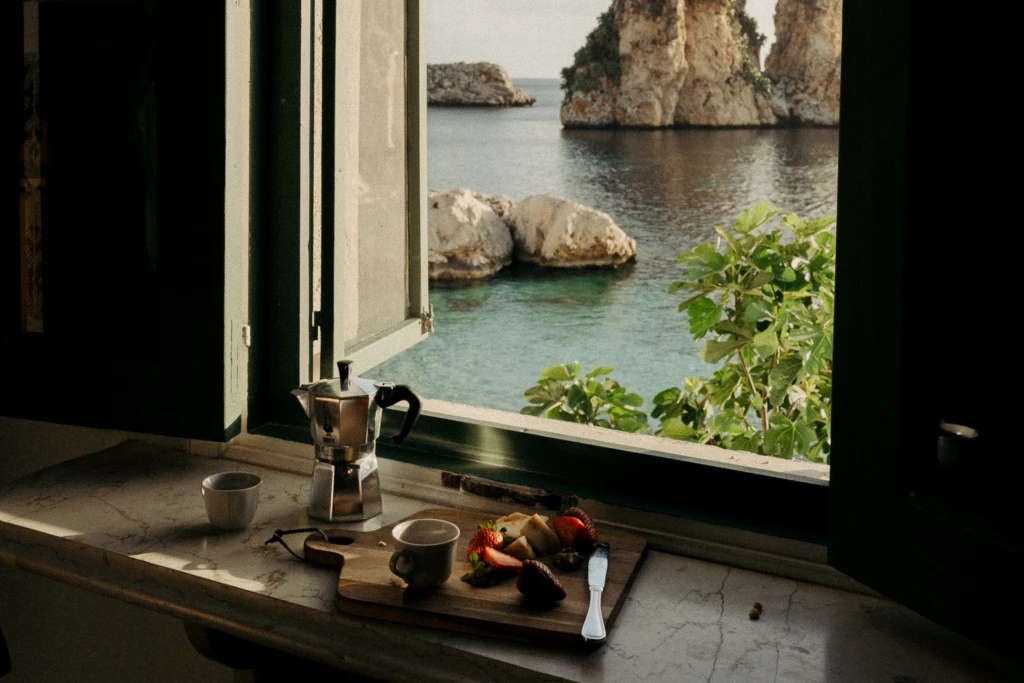Pedalling South: A Slow Journey from Tuscany to Palermo
Pedalling South: A Slow Journey from Tuscany to Palermo
This spring, Plinius co-founder Bodo will set off on a cycling adventure that captures the heart of slow travel. Starting in the charming Tuscan village of Trequanda, he’ll take his 3T Bike, three close friends, and the trusted route mapped out by Dutch cyclist Hans Reitsma—an inspiring path that leads to Palermo.
Over the coming weeks, Bodo will follow quiet backroads, pass through hilltop villages, wind along the coast, and experience Italy at a slower pace. It’s a journey shaped not by speed, but by connection—with landscapes, food, and the people met along the way.
This is a sneak peek of his route and what lies ahead—an invitation to follow the ride, be inspired, and rediscover Italy one slow turn of the pedals at a time.

Rome – Salerno
Leaving Rome, the journey begins along the Via Appia Antica, an ancient Roman road lined with cypress trees and historic tombs. Known as the Regina Viarum (Queen of Roads), it offers a unique and atmospheric start. Some original cobblestone sections make cycling nearly impossible, but unofficial bike paths have formed in the grass. Occasionally, you may need to walk your bike—a small price to pay for avoiding the heavy traffic of Rome’s outskirts.
The first 40 km out of Rome are quite busy, so taking a train to Valmontone might be a better option. Beyond Valmontone, the route becomes quieter, and further along, there’s even a 30 km cycling path on a former railway line.
For the next 350 km, the route winds through Italy’s interior, crossing broad valleys and mountain landscapes. Shortly after Pompeii, you reach the Sorrento Peninsula, offering stunning views of Naples and Mount Vesuvius. On the other side of the peninsula lies the famous Amalfi Coast, where the breathtaking scenery of dramatic cliffs and deep coves is softened by lush Mediterranean vegetation and picturesque villages.
For a less demanding and shorter alternative, you can follow the inland route via Benevento to Salerno.
Salerno – Messina
Beyond Salerno, the coastline is initially flat, featuring beautiful sandy beaches, but after the Greek temples of Paestum, it turns rocky, with occasional sandy stretches. Here, the route crosses the Cilento National Park, alternating between coastal paths and inland routes through the hills. After this stunning park, you reach the Gulf of Policastro, which is even more spectacular, offering a mix of seaside roads and high-altitude panoramic routes.
As you continue toward Calabria, the landscape remains rugged, but small bays with sandy beaches become more frequent. The route follows scenic palm-lined boulevards but also diverts onto quiet backroads and hilly inland paths to avoid the main highways. Occasionally, you’ll encounter short gravel sections.
Beyond the Gulf of Policastro, the coastline becomes less dramatic. If you have the time and stamina, consider the alternative mountain route through Calabria, which offers a more remote and exhilarating ride. Nearing Messina, the final stretch along the mainland provides stunning views of the Strait of Messina, with Sicily visible on the horizon.
Messina – Palermo
The first 60 km along Sicily’s east coast can be busy, so you may opt for a train to Alcántara. From there, the route leads inland through the Alcántara River Valley, which features dramatic gorges carved into volcanic rock. Gradually climbing along the foothills of the mighty Mount Etna, you’ll enjoy views of its often snow-capped peak for many kilometers.
This part of the route traverses Sicily’s most mountainous regions, including the Nébrodi and Madonie—home to some of the island’s highest peaks after Etna. These remote mountain villages, built from rustic stone, offer incredible views but are widely spaced, so be sure to stock up on food and water.
After crossing the Madonie Regional Park, you descend to the coast for the final stretch to Palermo. Due to traffic, you may prefer to take a train for this last section. Palermo, Sicily’s vibrant capital, is a treasure trove of architecture, blending Arab-Norman, Baroque, and Mediterranean influences.
Alternative Routes Around Rome
If you’re not starting in Rome but arriving via Reitsma’s Route to Rome, you can avoid the busy roads south of the city by following the Route around Rome. This detour starts near Assisi (main route) or Lake Bolsena (Tuscany route).
This alternative is not only quieter but also shorter and easier, especially if coming from Assisi, as it mostly runs parallel to mountain ranges without steep climbs. The route rejoins the main itinerary near Cassino.
For those who prefer a more mountainous challenge, there’s an option to transition from the Route around Rome to the Abruzzo Route and then possibly onto the Molise Route. Abruzzo is home to the highest and wildest sections of the Apennines, attracting nature-loving Italians and motorcyclists on summer weekends but remaining peaceful otherwise. Molise, in contrast, features rolling farmland, dense forests, and quiet villages, offering an even more tranquil ride than Abruzzo.
If starting in Rome but craving mountain adventure, consider taking a train to Carsóli, Tagliacozzo, or Avezzano to connect directly to the Abruzzo Route. Unfortunately, there are no truly quiet cycling routes from Rome to these starting points.
Alternative Route Through the Mountains of Calabria
After the Gulf of Policastro, the coastline becomes less scenic, and some sections require cycling on busy highways. If you have the time and endurance, consider the Calabrian Mountain Route, which is longer (283 km instead of 169 km) and more demanding (4,235 m elevation gain instead of 1,715 m), but rewards you with spectacular landscapes.
This route first climbs the coastal mountains, then crosses a broad valley before ascending into the Sila National Park. Here, you’ll find an unexpected landscape: a rolling high plateau (1,200–1,500 m) with lakes and vast pine forests, resembling Sweden rather than Italy.
The route partly follows the Ciclovia Parchi Calabria, a cycling trail that meanders through four national parks in Calabria. It’s a true adventure, requiring steep climbs over the coastal mountains before reaching the official cycling trail. Though not designated as a nature park, the coastal mountains offer breathtaking scenery.
The Ciclovia Parchi Calabria is marked as CPC on OpenStreetMap, primarily following quiet country roads. In northern Calabria, a short section runs along a converted railway track, providing a rare stretch of dedicated cycling infrastructure in this rugged terrain.



